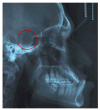Oral Manifestations and Maxillo-Facial Features in the Acromegalic Patient: A Literature Review
- PMID: 35207363
- PMCID: PMC8878286
- DOI: 10.3390/jcm11041092
Oral Manifestations and Maxillo-Facial Features in the Acromegalic Patient: A Literature Review
Abstract
Background: Acromegaly is a chronic disease caused by an abnormal secretion of growth hormone (GH) by a pituitary adenoma, resulting in an increased circulating concentration of insulin-like growth factor 1 (IGF-1). The main characteristics are a slow progression of signs and symptoms, with multisystemic involvement, leading to acral overgrowth, progressive somatic changes, and a complex range of comorbidities. Most of these comorbidities can be controlled with treatment. The literature reveals that the most evident and early signs are those related to soft tissue thickening and skeletal growth, especially in the head and neck region. Methods: The authors reviewed the available literature on the clinical oro-dental features of acromegaly, selecting articles from PubMed and Google Scholar. The aim of this review was to summarize all the reported clinical oro-dental features of acromegalic patients. Results: The most common facial dimorphisms involved the maxillo-facial district, with hypertrophy of the paranasal sinuses, thickening of the frontal bones, and protruding glabella, which may be associated with joint pain and clicks. Regarding the oro-dental signs, the most frequent are dental diastema (40-43%), mandibular overgrowth (22-24%), mandibular prognathism (20-22%), and macroglossia (54-58%). These signs of acromegaly can be significantly reduced with adequate treatment, which is more effective when initiated early. Conclusions: Increased awareness of acromegaly among dentists and maxillo-facial surgeons, along with the early identification of oro-facial changes, could lead to an earlier diagnosis and treatment, thereby improving patients' quality of life and prognosis.
Keywords: acromegalic features; acromegaly; acromegaly oro-dental diagnosis; dental manifestations acromegaly; dentist acromegaly; oral manifestations acromegaly; oro-dental acromegaly.
Conflict of interest statement
The authors declare that there are no conflict of interest regarding this publication.
Figures



Similar articles
-
The role of the dentist and orthodontist in recognizing oro-facial manifestations of acromegaly: a questionnaire-based study.Pituitary. 2022 Feb;25(1):159-166. doi: 10.1007/s11102-021-01183-y. Epub 2021 Sep 13. Pituitary. 2022. PMID: 34518997 Free PMC article.
-
Acromegaly: clinical features at diagnosis.Pituitary. 2017 Feb;20(1):22-32. doi: 10.1007/s11102-016-0772-8. Pituitary. 2017. PMID: 27812777 Review.
-
Acromegaly in humans and cats: Pathophysiological, clinical and management resemblances and differences.Growth Horm IGF Res. 2024 Jun;76:101595. doi: 10.1016/j.ghir.2024.101595. Epub 2024 May 24. Growth Horm IGF Res. 2024. PMID: 38810595 Review.
-
Acromegaly.Orphanet J Rare Dis. 2008 Jun 25;3:17. doi: 10.1186/1750-1172-3-17. Orphanet J Rare Dis. 2008. PMID: 18578866 Free PMC article. Review.
-
Assessment of oro-dental manifestations in a series of acromegalic patients, the AcroDent study.Endocr Connect. 2020 Aug;9(8):824-833. doi: 10.1530/EC-20-0176. Endocr Connect. 2020. PMID: 32738132 Free PMC article.
Cited by
-
Craniofacial impact of acromegaly: when muscle ma-sse-tter.Pituitary. 2024 Oct;27(5):437-439. doi: 10.1007/s11102-024-01436-6. Epub 2024 Jul 26. Pituitary. 2024. PMID: 39060818 No abstract available.
-
Significance of Multidisciplinary Teams for Patients with Oral and Maxillofacial Surgical Diseases: An Observational Retrospective Study in a General Hospital in China.J Multidiscip Healthc. 2024 Dec 30;17:6187-6198. doi: 10.2147/JMDH.S504720. eCollection 2024. J Multidiscip Healthc. 2024. PMID: 39759085 Free PMC article.
-
Oral Health and Quality of Life in Acromegaly: A Questionnaire-Based Study.Dent J (Basel). 2025 May 22;13(6):226. doi: 10.3390/dj13060226. Dent J (Basel). 2025. PMID: 40559129 Free PMC article.
-
The evaluation of changes in maxillofacial bones using cone beam tomography in acromegaly.Med Oral Patol Oral Cir Bucal. 2022 Jul 1;27(4):e357-e365. doi: 10.4317/medoral.25280. Med Oral Patol Oral Cir Bucal. 2022. PMID: 35717618 Free PMC article.
References
Publication types
LinkOut - more resources
Full Text Sources
Miscellaneous

